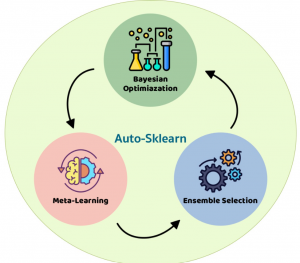
In this post, you will learn about Automated Machine Learning (AutoML) frameworks for Python that can use to train machine learning models. For data scientists, especially beginners, who are unfamiliar with Automl, it is a tool designed to make the process of generating machine learning models in an automated manner, user-friendly, and less time-consuming. The goal of Automl is not just about making it easier for machine learning (ML) developers but also democratizing access to model development.
What is AutoML?
AutoML refers to automating some or all steps of building machine learning models, including selection and configuration of training data, tuning the performance metric(s), selecting/constructing features, training multiple models, evaluating model performance, and selecting the best model.
AutoML considers multiple machine learning algorithms (random forests, linear models, SVMs, etc.) in a pipeline with multiple preprocessing steps (missing value imputation, scaling, PCA, feature selection, etc.), the hyperparameters for all of the models and preprocessing steps, as well as multiple ways to ensemble or stack the algorithms within the pipeline.
The advantage of using AutoML is that it automates the most time-consuming and least interesting part of machine learning. It allows data scientists to concentrate on more creative and strategic tasks rather than wasting time automating laborious yet computationally demanding modeling stages.
The disadvantage of using AutoML is that automating pre-processing and feature engineering can make it difficult to identify whether the model is overfitting. Additionally, automating the model training might not always result in a good performance.
What are some AutoML frameworks in Python?
The following is the list of AutoML frameworks in Python:
- Auto-sklearn: Auto-Sklearn is an open-source Python library designed to automate machine learning (AutoML) tasks. Through this, you will save time and have a more enjoyable experience setting up your ML model. It automates the most time-consuming but least interesting aspect of machine learning: model choice and hyperparameter tuning for a variety of classifiers, regressions, and clustering algorithms. Auto-sklearn implements a wide variety of ML algorithms including support vector machines (SVM), random forests, gradient boosting machines (GBM), k-means etc.
- SMAC: SMAC (sequential model-based algorithm configuration) is an Automl library in Python that automates training multiple models (grid search) as well as evaluating model performance for classification or regression problems using many standard evaluation metrics such as accuracy.
- DataRobot: DataRobot provides automated machine learning on-demand for predictive models. It automates feature engineering, model selection and hyperparameter optimization using all available data without needing to retrain the model.
- Amazon Sagemaker AutoPilot: Amazon Sagemaker AutoPilot automates machine learning model training and scaling in a serverless, distributed fashion. It is a fully managed service for deploying machine learning models at any scale on Amazon ECM or Amazon SageMaker.
- Google Cloud AutoML: Google cloud provides AutoML as a cloud service. It automates model training and hyperparameter tuning for machine learning problems such as image classification, natural language processing (NLP), sentiment analysis, etc.
- Azure AutoML: Microsoft Azure’s AutoML automates machine learning through its custom algorithms used to configure, train, and score models with the most appropriate machine learning algorithm for your problem.
- H20 Automl: AutoML from H2O enables you to automate the machine learning process, which entails automatic training and tweaking of many models within a user-determined time limit. Stacked ensemble models will be automatically trained on collections of individual models to generate highly predictive ensemble models.
- TPOT: TPOT automates the process of finding good features and building accurate predictive models by intelligently exploring your dataset in search for patterns using sophisticated techniques such as genetic programming. The advantage of using TOPT is that it automates all the complex machine learning tasks such as data processing, model selection and parameter tuning.
- AutoKeras: AutoKeras automates machine learning through a set of high-level APIs in Python, which automates pre-processing steps such as feature extraction and scaling. The advantage of using AutoKeras is that it automates all the complex machine learning tasks such as data processing, model selection and parameter tuning.
- Databricks AutoML: Databricks AutoML allows you to quickly generate baseline models and notebooks. It automates machine learning through its MLlib library, which automates pre-processing steps such as feature extraction and scaling. The advantage of using Databricks AutoML is that it automates all the complex machine learning tasks such as data processing, model selection, and parameter tuning.
- Hyperopt: HyperOpt is an open-source library for large-scale AutoML. HyperOpt-Sklearn is a wrapper for HyperOpt that supports AutoML with HyperOpt for the popular Scikit-Learn machine learning library, including the suite of data preparation transforms and classification and regression algorithms.
- MLBox: MLBox is an open-source Python library that automates machine learning tasks such as data pre-processing, model training and evaluating machine learning models. It provides the following features: Fast reading and distributed data preprocessing / cleaning/ formatting. Highly robust feature selection and leak detection. Accurate hyper-parameter optimization in high-dimensional space.
- Ludwig: Ludwig is a toolbox that allows users to train and test deep learning models without the need to write code.
- AutoGluon: AutoGluon enables easy-to-use and easy-to-extend AutoML with a focus on automated stack ensembling, deep learning, and real-world applications spanning text, image, and tabular data.
- Three Approaches to Creating AI Agents: Code Examples - June 27, 2025
- What is Embodied AI? Explained with Examples - May 11, 2025
- Retrieval Augmented Generation (RAG) & LLM: Examples - February 15, 2025
I found it very helpful. However the differences are not too understandable for me